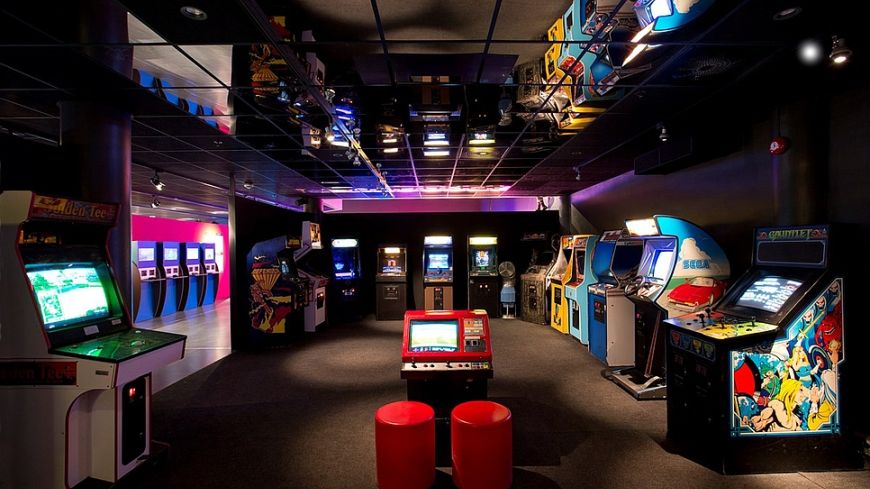
We need to pass the torch, and let our children read our messy and sad history by its light. We have all the magic of the digital age to do that with … Building the future and keeping the past alive are one and the same thing.” – Metal Gear Solid 2: Sons of Liberty.
Twenty years ago, the National Museum of Scotland was the first touring venue for Game On, the largest interactive exhibition of the history and the culture of video games.
Now after being seen by over five million people in 24 cities around the world, it has been given a reboot.
Even in that relatively short time video gaming has grown from its bedroom and arcade domains of early 8-bit machines and consoles to a business that overshadows the Hollywood film industry. Back in 2010 video games brought in $25 billion, double Tinseltown’s box-office takings. People have never played more video games and they are estimated to have more than three billion users, with some games having over 3 million concurrent participants.
But we are getting ahead of ourselves. The exhibition’s story begins with a huge tape driven and teletype-controlled machine which over 60 years ago would have played Spacewar!, something akin to Asteroids. This inspired the Pong and Space Invader machines which follow.
There is a temptation to rush past these antechambers, lured on by Pac-Man’s “waka, waka”, myriad glowing screens and glittering cases displaying the loot of top 10 consoles and computers. This however would be to miss gems such as the framed concept art for Space Invaders and the little Easter egg that Pac-Man (1980) was going to be Puck-Man before fear of easy “editing” to something not PG drove a rebranding. Here also are historical connections to some game pioneers, figures such as Allan Alcorn, Carol Shaw and Gunpei Yokio along with a local one in the form of a donated heavily modified Spectrum.
The glittering prizes of the inner sanctum contains sections of machines split by colour coded genre, arcade machines, virtual reality and more. A huge photo backdrops the Arcade section showing the long gone and sadly missed Amusements of local seaside Porty (Portobello) which was the venue of many a first encounter in the 70’s.
There are over 100 games to play without the need to feed the hungry coin slots and gloriously free of microtransactions, both iconic ones and lesser-known Scottish developed ones. The Vibrant Scottish industry has not just major players such as Rockstar and 4J Studios but some familiar games that you might not know have Scottish roots along with newer lesser knowns such as Pine Hearts, a cosy narrative adventure puzzler and the charming Highland Song by Inkle, exploring the landscape with Moira, a 15-year-old girl who has never seen the sea.
A shining display case contains hand-held devices from Mattel, Tomy, Nintendo and many more with an adjacent table where they can be experienced hands on. The section on the VR journey has only just begun and with specially composed scores and Hollywood actors appearing in hyper realistic games the boundaries with film are merging. Often demonised there is a nod towards research findings on the benefits of video games, particularly the potential that they hold for interventions that promote well-being and mental health.
The focus is very much on the interactive experience, and it would be engaging to see a few more static exhibits on the history, or taking something like the long running Tomb Raider series to actually display the advancements that tech has afforded. Video games are socially interactive in a way never before offered. While arcades used to be the hub of videogames online players are increasingly gaming with friends, family, and total strangers, across enormous geographical distances and blurring cultural, socioeconomic and generational boundaries. When not gaming some 240 million monthly users interact via the Twitch streaming platform on 7.3 million distinct channels. This is something that the exhibition could explore, perhaps with some talking head interviews with professional streamers.
There is no denying that the hands on approach is proving hugely popular with many sessions selling out.
It is in the nature of gamers to want more, just one more go … There is room for the exhibition to grow and be updated (there are over 100,000 games available on the Steam platform alone), but it would take many lifetimes to do it justice and there are no infinite lives, as many a gamer has said, “YOLO”.
Beside the exit is a glowing projection – “One of the greatest aspects of the medium of videogames is the constant change. For me we are literally making the future, we are creating where people will live, meet, and have fun. The exciting thing now is where we go next” – Aaron Garbut, Rockstar North.
We can look forward to looking back in another 20 years.
Exhibition Times: 29 June to 3 November 2024 at 10am to 3pm on 30-minute intervals. To ensure a positive experience for all visitors, the maximum time allowance within the exhibition space is two hours.
Tickets: £12 - £15 (adult), £8 - £11 (child, under 5 free) (other concessions and discounts apply). Free to Members.
Suitability: Suitable for all subject to discretion. All recent videogames contained in the exhibition have been rated by the European PEGI certification system. These ratings are noted for visitors on accompanying panels, including for games rated 12, 16 or 18+. See website for other details.

